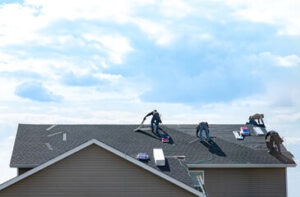What You Should Know About Roofing Contractors
Roofing Contractors In Columbus GA have the experience and skills to install, repair, or replace roofing. They also know how to understand building codes, materials, and manufacturers.

They know how to work with insurance companies and can streamline that process. They can provide excellent customer service and offer affordable rates.
The experience of roofing contractors is an essential factor that determines the quality of roofing projects. They know how to work with a wide variety of materials and have the knowledge to make informed choices that ensure structural integrity and longevity. In addition, their accumulated expertise allows them to anticipate challenges and take proactive steps to circumvent complications. This enhances project outcomes and protects structural integrity and property value.
Experienced roofers are also trained in other parts of the house that work with the roof or are closely linked to it. They have a deep understanding of windows, sidings, gutters, insulation and other areas that work with the roof, and they can help you get the best possible outcome for your home. They also have the skills to safely carry out roofing jobs and use the right equipment, such as sponge pads, special footwear, ropes, harnesses and ladders.
A roof is a vital structure that safeguards your property and family. It’s important to have a roofing contractor with experience in installing a wide range of roofs, so you can rest assured that your project will be done well and on time. In addition, an experienced roofer will have a strong working relationship with manufacturers and suppliers, which can help you obtain the best products at the most cost-effective prices.
Unlike general contractors, who can handle many different types of construction, roofing contractors specialize in roofing and have the knowledge and skills to complete your re-roofing project on schedule. In addition, they can provide you with a range of options for your roof and can offer you a warranty to back their work.
Roofing contractors often have an online scheduling system that lets you book appointments at your convenience. They may have a sales person that will meet with you and present you with samples of various roof shingles and roofing systems. They can also give you advice about your insurance claim if you’re replacing an old roof due to storm damage. If you’re not happy with the salesperson, you can always find another one.
License
The roofing industry is one of the most heavily regulated industries in the United States, so it’s not surprising that Roofing Contractors must have the proper license to work. The process for getting a license differs by state, but it generally includes passing a licensing exam and meeting local requirements. These may include background checks, credit requirements, and age or education criteria. In some cases, it’s also necessary to get insurance, like liability coverage and worker’s compensation.
The Department of Commerce, Community and Economic Development oversees licensing for commercial construction projects and residential remodeling projects. To obtain a license, you must pass a trade and business law exam, place a bond, and prove that you have at least three years of experience. You must renew your license every two years. If you change your general information, this must be reflected in the renewal application.
Most states require that you have a general contracting license before you can perform roofing work, but there are some exceptions. For instance, you can only work on a home improvement project if you have a roofing contractor license. To obtain a license, you must complete a pre-licensing course and pass an exam.
You can check the status of a license by visiting the state’s website and performing a contractor search. The results will provide you with important information about the contractor, including their professional history and current license status. If the contractor has been disciplined by the state, this will be noted on their record.
Roofing contractors are responsible for the selection and purchase of building materials, as well as the construction of roofs. Those who work on large commercial projects must also have a general construction contracting license. In addition, some states require a license to work with asbestos. This is because of the health risks associated with this product, so it’s best to avoid working with unlicensed contractors if possible. However, this is not always possible, so it’s a good idea to contact your local government for more information about the requirements in your area.
Insurance
Roofing contractors are exposed to high levels of risk due to the physical demands of the job. They need adequate insurance to protect their business from financial loss due to third-party property damage or injuries. In addition, this type of commercial liability insurance protects them against lawsuits for libel, slander, copyright infringement, false arrest and invasion of privacy.
The cost of the policy can vary depending on the amount of coverage purchased and the insurance company offering it. Many insurance agents recommend purchasing a small business package that includes general liability, workers’ compensation and commercial property insurance to save money. To help save on premium costs, you can also purchase an umbrella insurance policy that provides additional protection above the limits of your base policies.
Homeowners prefer engaging roofing contractors with adequate insurance to ensure their safety and protect their assets. In addition, it is a requirement in most states, including New York. Besides protecting yourself from liability issues, having this insurance demonstrates reliability and trustworthiness to clients, making your business more appealing to potential customers.
General liability insurance covers property damage, bodily injury and legal expenses. For example, a falling tool or debris might hurt a pedestrian or damage their vehicle or home. Additionally, if one of your employees sustains an injury while working at a client’s location, workers’ compensation insurance pays for medical expenses and lost wages.
In addition, it is essential to obtain commercial auto insurance, which is a type of business auto insurance that covers cars, trucks and vans that are owned by your roofing company and used for work-related purposes. This insurance is important as personal auto insurance typically does not cover business-related accidents and damage.
Lastly, you need to have a tool and equipment insurance policy, which is a type of business property insurance that reimburses you for the tools or equipment you use in your work. You can also get an inland marine insurance policy to cover the transport of equipment across water or land. You can find these types of policies in the form of standalone policies or as part of a larger commercial insurance package.
Warranty
If you have been looking into replacing or repairing your roof, you may be confused about the various warranty options available. Generally, there are two types of warranties that you should consider: workmanship and manufacturer material warranties. Having both will ensure you have the most comprehensive coverage possible.
Workmanship warranties are a critical component of any roofing job. These will cover any installation errors by the contractor. While many manufacturers will offer a product and materials warranty, they don’t typically include a workmanship warranty with their products. This can lead to confusion and misunderstandings, especially when a homeowner files a claim against their manufacturer warranty only to find out that the problem wasn’t due to a manufacturing defect but rather an installation error.
When selecting a roofing contractor, look for one that offers workmanship warranties and has a long history in the industry. This will help you feel confident that they are a stable local business and will be around to provide service should the need arise. Additionally, you will want to make sure they are a certified installer for the product that is being installed at your home. This will help protect you from “storm chasers,” contractors who show up after a storm to take advantage of the desperate homeowners who need their services.
Another thing to consider is the length of the roofing warranty offered. Ideally, you will want to choose a roofing company that offers no-dollar limit warranties as opposed to prorated warranties. These will cover the entire cost of a repair, whereas prorated warranties only cover a percentage of the cost.
It is also important to understand the difference between a product and materials warranty and a system warranty, as these will determine what exactly is covered by your warranty. A product and materials warranty covers the actual shingles and other roofing materials, while a system warranty covers the entire roof assembly from the underlayment to the ventilation products. Typically, the system warranty will have a longer manufacturer’s warranty than the shingle and product warranties. In addition, the manufacturer’s system warranty will often be transferable to a new homeowner, which is a big benefit for those who plan on selling their homes in the future.
Hello world!
Welcome to WordPress. This is your first post. Edit or delete it, then start writing!
